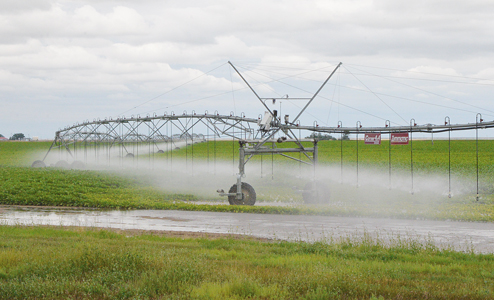Current Temperature
15.1°C
Work continues to make irrigation more efficient
Posted on January 22, 2020 by Taber Times TIMES FILE PHOTO
TIMES FILE PHOTOBy Dave Mabell
Alta Newspaper Group – Lethbridge
Check your menu: It takes 11 litres of water to create a head of lettuce, 30 to grow a tomato, but 240 to produce a chicken egg.
Those are some of the calculations to be considered in our use of water, participants at the Southern Alberta Council on Public Affairs learned recently.
But your average hamburger involves more than 2,300 litres, speaker Terrence Lazarus reported. And a typical steak? It weighs in around 4,660 litres each, he said.
Nearly all food production, harvesting, washing and transportation depends directly or indirectly on water. And for southern Albertans, those uses of water are a key to the agri-food industry and the basis of their economy.
General manager of the St. Mary River Irrigation District, Lazarus pointed out the first irrigation systems were built high in the foothills before the end of the 19th century. Early construction projects brought irrigation water to Lethbridge-area farms in 1900.
And the Canadian Pacific Railway continued building canals and laterals until the Second World War. The St. Mary system, largest in Canada, inherited much of that infrastructure but extended the system all the way to Medicine Hat after the St. Mary Dam was completed in 1948.
Today, Lazarus said, the area served by the St. Mary system and partners like the Taber Irrigation District is close to 400,000 acres. It’s also created about 87,000 acres of wetland habitat, he said – due to canal leakage.
Intensive production of cereal crops, potatoes and much more has attracted a dozen major industrial operations like Cavendish Farms to the region, he pointed out. In Lethbridge alone, there are 170 ag-related businesses.
So what’s ahead? Irrigation systems and farm operations will continue to become more efficient, he predicted. Irrigation water could be supplied on the basis of measured volume, rather than by the day.
And increasingly, producers may consider what crops bring the greatest return versus the water used.
No water is actually lost, he emphasized. Water on the luncheon tables may have been previously used by dinosaurs, he joked.
Irrigation systems must work on renewing their “social licence” in today’s environment, Lazarus suggested. That wasn’t a consideration when dams were being built a century ago, but today’s citizens are much more involved in those issues.
And rather than creating more reservoirs, irrigation districts will encourage producers to find ways of storing more water on their land. Lazarus cited the example of an onion producer east of Lethbridge who has done just that, allowing an earlier planting time with the water needed to get the crop started.
Climate change will certainly be another issue, he said.
But it’s not yet clear whether that would bring southern Alberta more precipitation, or less.
Questioned about the region’s solar energy potential, Lazarus said the St. Mary system has installed solar panels in a number of locations. But he said suggestions to use panels as a canopy over the canals is not practical because canals need to be readily accessed for maintenance.
Lazarus did agree with comments that plastic-packaged water is a wasteful use of the resource.
“Tap water is much safer than bottled water” because it’s subject to more testing, he said. And it involves no throw-away plastic.
Better to fill a flask with tap water before leaving home in the morning, he maintained.
Leave a Reply
You must be logged in to post a comment.

